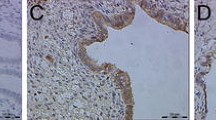Abstract
Estrogens play a crucial role in maintaining ovarian function. Deregulation of estrogen signals is associated with fertility-impairing disorders. The aim of this study was to investigate whether the G-protein-coupled estrogen receptor (GPER) is present in the human ovary. Additionally, we analyzed the folliculogenesis and ovarian endometriosis in GPER expression. Seventy-nine patients (ovarian endometriosis, n = 26; ovarian pelvic inflammatory disease [PID], n = 10; normal ovaries/endometrium, n = 30/13) were analyzed by immunohistochemistry. Normal ovaries were also assessed by real-time polymerase chain reaction and double immunofluorescence. The most intense expression of GPER was noted in the ovarian surface epithelium. Theca cells and oocytes were also significantly positive. Expression of GPER was more frequent in mature follicles/oocytes than in primordial ones, implying that GPER could be a selector during folliculogenesis. Moreover, GPER was upregulated in ovarian endometriosis and PID. Overexpression of GPER in both inflammation and endometriosis affecting the ovary may prove useful in explaining/predicting the main endometriosis-related symptoms.
Similar content being viewed by others
References
Carmeci C, Thompson DA, Ring HZ, Francke U, Weigel RJ. Identification of a gene (GPR30) with homology to the G-protein-coupled receptor superfamily associated with estrogen receptor expression in breast cancer. Genomics. 1997;45(3): 607–617.
Kvingedal AM, Smeland EB. A novel putative G-protein-coupled receptor expressed in lung, heart and lymphoid tissue. FEBS Lett. 1997;407(1):59–62.
Takada Y, Kato C, Kondo S, Korenaga R, Ando J. Cloning of cDNAs encoding G protein-coupled receptor expressed in human endothelial cells exposed to fluid shear stress. Biochem Biophys Res Commun. 1997;240(3):737–741.
Owman C, Blay P, Nilsson C, Lolait SJ. Cloning of human cDNA encoding a novel heptahelix receptor expressed in Burkitt’s lymphoma and widely distributed in brain and peripheral tissues. Biochem Biophys Res Commun. 1996;228(2):285–292.
Revankar CM, Cimino DF, Sklar LA, Arterburn JB, Prossnitz ER. A transmembrane intracellular estrogen receptor mediates rapid cell signaling. Science. 2005;307(5715):1625–1630.
Chimento A, Sirianni R, Zolea F, et al. Gper and ESRs are expressed in rat round spermatids and mediate oestrogen-dependent rapid pathways modulating expression of cyclin B1 and Bax. Int J Androl. 2010. 34(5 Pt 1):420–429.
Filardo EJ, Quinn JA, Frackelton AR, Jr, Bland KI. Estrogen action via the G protein-coupled receptor, GPR30: stimulation of adenylyl cyclase and cAMP-mediated attenuation of the epidermal growth factor receptor-to-MAPK signaling axis. Mol Endocrinol. 2002;16(1):70–84.
Pandey DP, Lappano R, Albanito L, Madeo A, Maggiolini M, Picard D. Estrogenic GPR30 signalling induces proliferation and migration of breast cancer cells through CTGF. EMBO J. 2009; 28(5):523–532.
Suzuki T, Sasano H, Kimura N, et al. Immunohistochemical distribution of progesterone, androgen and oestrogen receptors in the human ovary during the menstrual cycle: relationship to expression of steroidogenic enzymes. Hum Reprod. 1994;9(9):1589–1595.
Tan XJ, Lang JH, Zheng WM, Leng JH, Zhu L. Ovarian steroid hormones differentially regulate thrombospondin-1 expression in cultured endometrial stromal cells: implications for endometriosis. Fertil Steril. 2010;93(1):328–331.
Nomura K, Murakami K, Shozu M, Nakama T, Yui N, Inoue M, Local application of danazol-loaded hyaluronic acid hydrogel to endometriosis in a rat model. Fertil Steril. 2006;85(suppl 1):1157–1167.
Kennedy S, Bergqvist A, Chapron C, et al. ESHRE guideline for the diagnosis and treatment of endometriosis. Hum Reprod. 2005; 20(10):2698–2704.
Filardo EJ, Graeber CT, Quinn JA, et al. Distribution of GPR30, a seven membrane-spanning estrogen receptor, in primary breast cancer and its association with clinicopathologic determinants of tumor progression. Clin Cancer Res. 2006;12(21):6359–6366.
Remmele W, Stegner HE. [Recommendation for uniform definition of an immunoreactive score (IRS) for immunohistochemical estrogen receptor detection (ER-ICA) in breast cancer tissue]. Pathologe. 1987;8(3):138–140.
Schroder AL, Pelch KE, Nagel SC. Estrogen modulates expression of putative housekeeping genes in the mouse uterus. Endocrine. 2009;35(2):211–219.
Poola I, Abraham J, Liu A, Marshalleck JJ, Dewitty RL. The cell surface estrogen receptor, G protein-coupled receptor 30 (GPR30), is markedly down regulated during breast tumorigenesis. Breast Cancer (Auckl). 2008;1:65–78.
Karita M, Yamashita Y, Hayashi A, et al. Does advanced-stage endometriosis affect the gene expression of estrogen and progesterone receptors in granulosa cells? Fertil Steril. 2011;95(3): 889–894.
Juhasz-Boss I, Hofele A, Lattrich C, Buchholz S, Ortmann O, Malik E. Matrix metalloproteinase messenger RNA expression in human endometriosis grafts cultured on a chicken chorioallantoic membrane. Fertil Steril. 2010;94(1): 40–45.
Gylfason JT, Dang D, Petursdottir V, et al. Quantitative DNA perturbations of p53 in endometriosis: analysis of American and Icelandic cases. Fertil Steril. 2005;84(5):1388–1394.
Kressin P, Wolber EM, Wodrich H, et al. Vascular endothelial growth factor mRNA in eutopic and ectopic endometrium. Fertil Steril. 2001;76(6):1220–1224.
Livak KJ, Schmittgen TD. Analysis of relative gene expression data using real-time quantitative PCR and the 2(-Delta Delta C(T)) Method. Methods. 2001;25(4):402–408.
Mowa CN, Iwanaga T. Differential distribution of oestrogen receptor-alpha and -beta mRNAs in the female reproductive organ of rats as revealed by in situ hybridization. J Endocrinol. 2000; 165(1):59–66.
D’Haeseleer M, Cornillie P, Simoens P, van den Broeck W. Localization of oestrogen receptors within various bovine ovarian cell types at different stages of the oestrous cycle. Anat Histol Embryol. 2006;35(5):334–342.
Drummond AE, Fuller PJ. The importance of ERbeta signalling in the ovary. J Endocrinol. 2010;205(1):15–23.
Pavlik R. et al. Induction of G protein-coupled estrogen receptor (GPER) and nuclear steroid hormone receptors by gonadotropins in human granulosa cells. Histochem Cell Biol. 2011;136(3): 289–299.
Sharma G, Prossnitz ER. Mechanisms of estradiol-induced insulin secretion by the G protein-coupled estrogen receptor GPR30/ GPER in pancreatic {beta}-cells. Endocrinology. 2011;152(8): 3030–3039.
Richards JS, Pangas SA. The ovary: basic biology and clinical implications. J Clin Invest. 2010;120(4):963–972.
Slot KA, Kastelijn J, Bachelot A, et al. Reduced recruitment and survival of primordial and growing follicles in GH receptor-deficient mice. Reproduction. 2006;131(3):525–532.
Author information
Authors and Affiliations
Corresponding author
Rights and permissions
About this article
Cite this article
Heublein, S., Lenhard, M., Vrekoussis, T. et al. The G-Protein-Coupled Estrogen Receptor (GPER) is Expressed in Normal Human Ovaries and is Upregulated in Ovarian Endometriosis and Pelvic Inflammatory Disease Involving the Ovary. Reprod. Sci. 19, 1197–1204 (2012). https://doi.org/10.1177/1933719112446085
Published:
Issue Date:
DOI: https://doi.org/10.1177/1933719112446085




